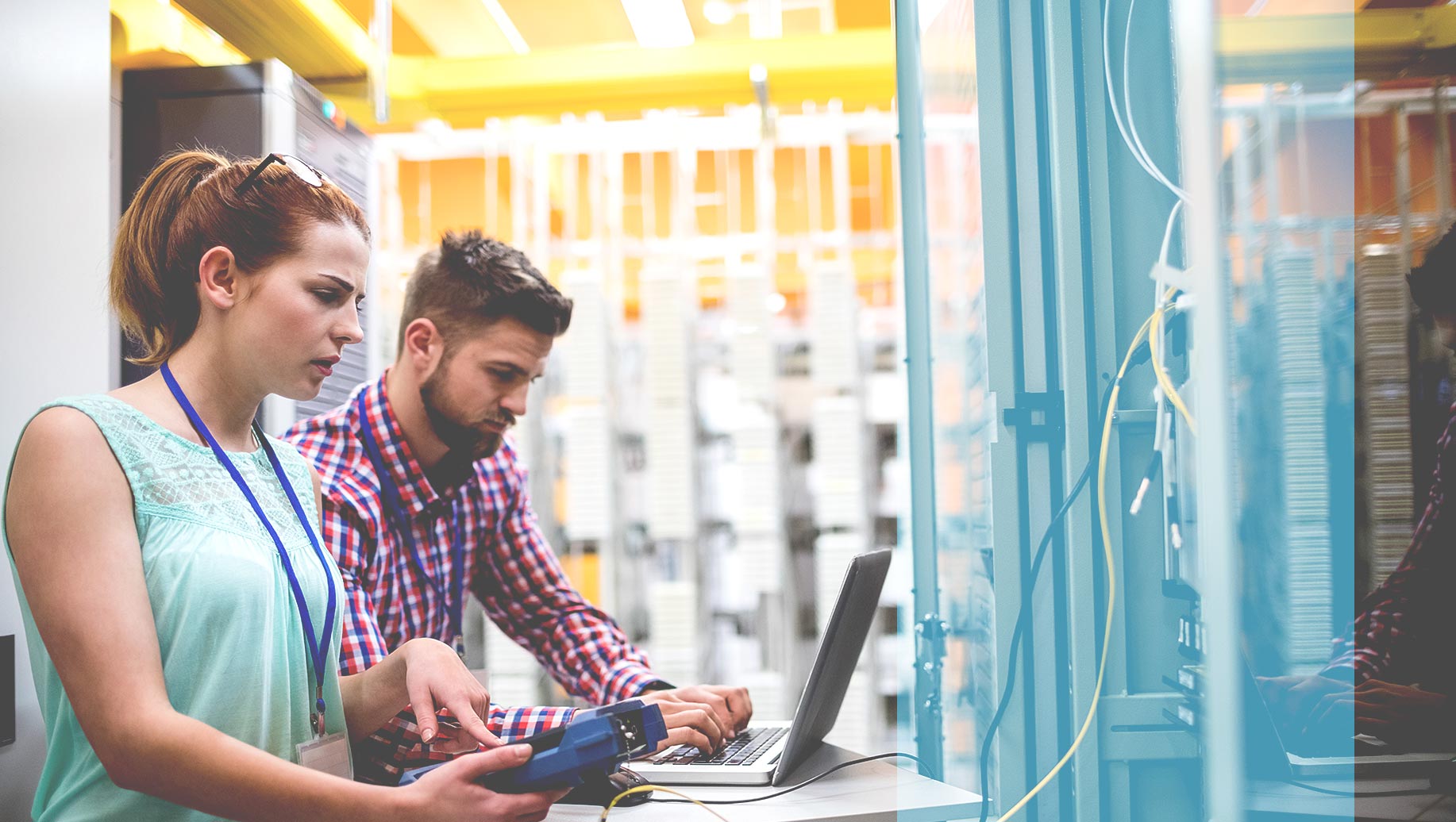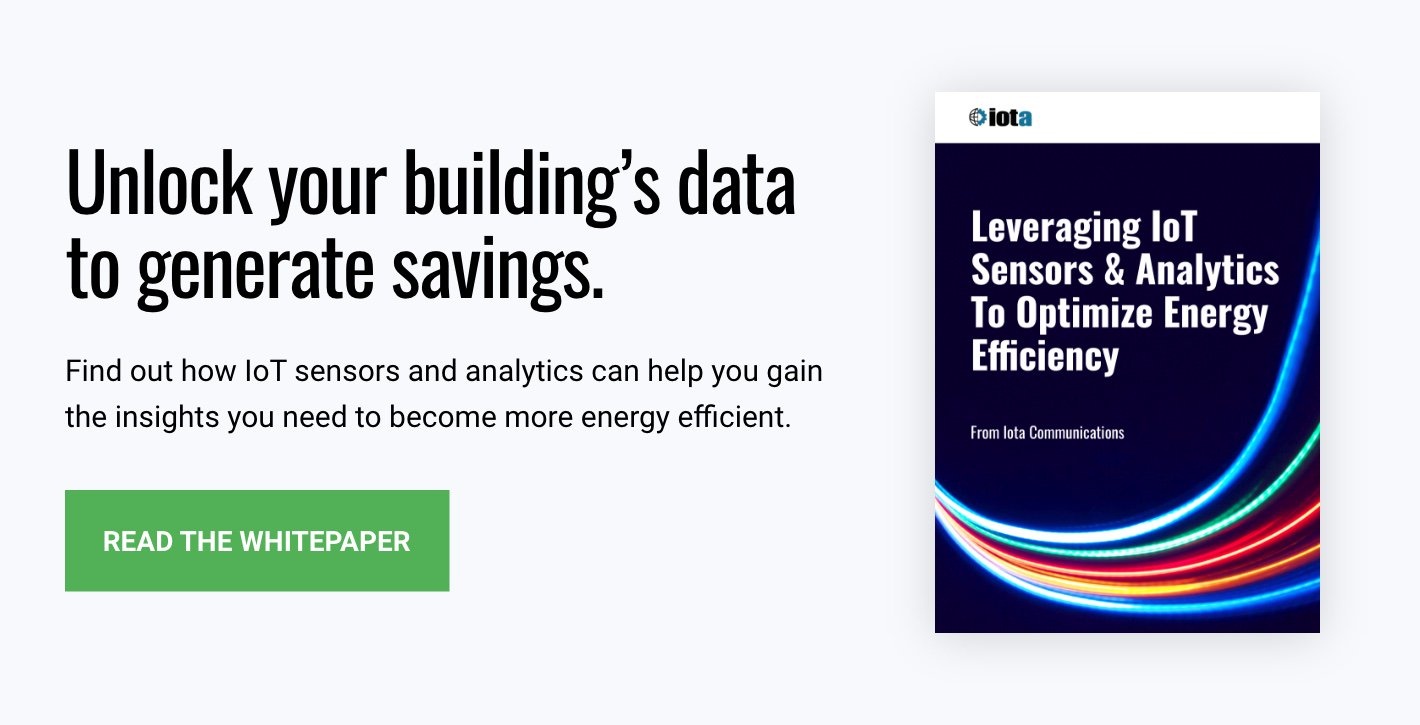Considering investing in an IoT (Internet of Things)-based remote monitoring system for your building (or buildings)? Whether you’re managing just one building or many, today’s remote monitoring solutions provide a highly detailed view of all your building operations, everywhere—and an unprecedented degree of control over them. So if your goals as a facilities manager include one or more of the following:
- To increase energy efficiency
- To create a more sustainable facility
- To lower your operating costs
- To adopt a predictive maintenance strategy
- To improve the occupant experience
… then an IoT monitoring system can help you reach them. Keep reading to find out more about remote monitoring with IoT devices, and how it can help you make the changes most important to you as a building manager.
Download this free whitepaper to read about the two most impactful IoT strategies building managers are using to improve performance.
The Value Of IoT-based Remote Monitoring Systems
A client recently described to me her current process for monitoring building operations: Every month, she travels to each of the eight buildings in her management portfolio with a pad and pen, and manually records data taken from 30 meters, give or take a few. The hidden transaction costs associated with this type of manual building monitoring system are high, both in terms of the time it takes to visit the facilities and the effort expended on meter reading. In addition, she also takes the risk of introducing errors into the data-gathering process, either in the reading or the recording of data.
While there are other options for remotely monitoring some aspects of your facility and/or equipment, such as RFID for tracking assets or cameras for providing 24/7 views of certain building areas, for example, the only option that greatly reduces the transaction costs associated with building management is the IoT.
[bctt tweet=”An IoT monitoring system is capable of capturing massive amounts of data about your facility, whether you’re there or not.” username=”iotacomm”]
An IoT monitoring system is capable of capturing massive amounts of data about your facility, whether you’re there or not. Here’s how it works:
IoT sensors accurately monitor whatever aspects of your building you prefer, whether it’s environmental conditions (such as temperature, light level, air quality characteristics, or anything else) or energy consumption of your systems or equipment. Data is captured remotely. Then, once collected, it is transmitted over the network and into the cloud, where you can then access it on your computer.
Remote monitoring reduces the hidden costs associated with traditional monitoring solutions in two ways:
- It lowers the cost of data-gathering. Manual monitoring requires having enough experienced staff members to monitor multiple properties continuously. With remote monitoring, fewer staff members are needed to gather data; also, the costs associated with travel between buildings is eliminated. And while purchasing a remote monitoring system (especially one with advanced analytics) does represent a financial investment, the cost can be spread out across buildings; also, such systems tend to have a very good ROI once targeted efficiency and cost-reduction strategies have been implemented.
- It makes the monitoring process more efficient. Digital data collection reduces the time it takes to gather building data and to analyze it as well. Plus, your IoT system is gathering and sharing data continuously, unlike traditional data collection systems which are only carried out periodically.
An IoT monitoring tool also has additional benefits:
- It provides more granular data about your building. IoT sensors are capable of gathering more detailed data than manual monitoring methods. Rather than just reading a meter periodically, you can attach sensors to individual pieces of equipment for strategic energy monitoring or thousands of individual assets for IoT asset tracking. Having an in-depth understanding of how your facility operates is the first step toward making meaningful changes.
- It offers more opportunities to implement change. The advanced analytics tools provided by most IoT monitoring systems produce more insights about your building than would be possible otherwise. As a result, you can take immediate steps to reach numerous goals, whether they relate to improving building operations or changing the way you manage and maintain your buildings.
Can you build a remote monitoring & management system yourself?The short answer is, yes, you can. However, know that there are a number of skill sets required to get a DIY remote monitoring system up and running. For example, most companies will need at least the following:
If you don’t have all the in-house talent you need, or prefer to have some guidance from professionals experienced in remote monitoring, it may be worth the investment to hire an IoT partner who can help you make the most of your investment. |
From Data To Insights: Reaching Your Goals
So how does remote monitoring lead to greater control over your building—and ultimately achieving your goals as a building manager?
We’ve already discussed how an array of IoT sensors and gateways make it possible to “track” in real time just about anything inside your facility. But a crucial piece of the process remains how to gain insights from the data. Even with an abundance of great data, if you can’t act on it, then it probably isn’t worth your time to collect in the first place.
Many IoT environmental monitoring systems have an advanced analytics component that helps you unlock real business value from your data. Your building has multiple parallel processes happening both inside and outside—they must be examined in relation to one another before significant insights can be gleaned. With the correct context surrounding your data streams, you have the right ingredients to make predictions and design strategies that will help you reach your goals. Briefly, here’s how analytics can help you do the following:
- Increase energy efficiency: An energy monitoring system can reveal the total daily electrical consumption of your building and the role individual devices play in your overall energy use. That data, combined with utility time of use charges and weather data, for example, could help you reduce the amount of energy you use during a utility’s “peak hours,” dramatically reducing the demand charge portion of your utility bill.
- Create a more sustainable facility: Energy use is directly connected to greenhouse gas emissions and other compounds; therefore it is the largest component of sustainability. Remote IoT monitoring systems provide quantifiable numbers you can use to show that your energy reduction strategies are working. That reduction can then be translated into environmental impact in terms of carbon offset and air pollution reduction. (Here’s a chart showing the average emissions per megawatt-hour of electricity reduction.)
- Lower your operating costs: Many buildings waste money by overspending on the electricity required for ventilation, usually because the amount of fresh air ventilation is based on peak occupancy. However, most buildings aren’t often reaching peak occupancy. IoT sensors can remotely monitor CO2 levels in the building (CO2 is a proxy for occupancy level), allowing you to regulate outside air intake to accommodate actual human occupancy and activity within the building. Such a system reduces the work for heating and cooling systems and therefore reduces your energy consumption—and your bill.
- Adopt a predictive maintenance strategy: IoT monitoring systems that incorporate machine learning and artificial intelligence (AI) technology can use predictive analytics to pinpoint when a piece of equipment is likely to fail, giving you time to address it before it happens. Paired with your critical assets, sensors can give you an unprecedented level of insight into your daily operations, allowing you to be more proactive about building maintenance. The caveat being it takes a significant amount of time for machine learning to assess equipment failure before predictive models can be formulated.
- Improve the occupant experience: A healthy environment has a direct impact on building performance and tenant retention. IoT monitoring tools can be used to continuously gather data about ventilation, air contaminants, and temperature and humidity levels in your building. As you continue monitoring over time, the data you receive will paint an accurate picture of your building’s overall air quality, and help you to know if you need to take corrective action.
Ready to equip your building(s) with a remote monitoring system?
Talk to us at Iota. Our goal is to help facility managers and businesses derive valuable insights from IoT monitoring. We’ll work with you to identify your goals, discuss opportunities where real-time data can be valuable, and set you up with a remote monitoring system that’s both cost-effective and easy to use. And we’ll be with you every step of the way, offering guidance on ways to optimize your data and your building operations. Reach out to us today and let’s get started.


